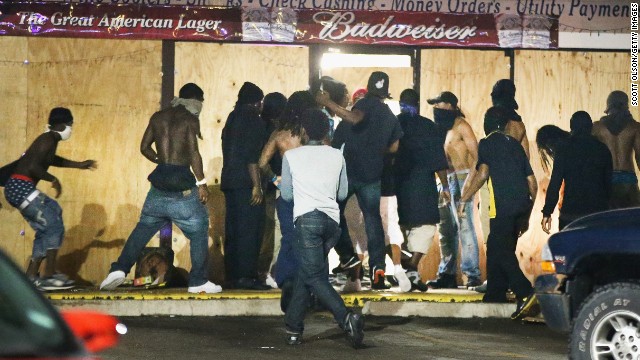Stuff Black People Don’t Like
December 14, 2104
National Review published a profile of the last white mayor of Ferguson, current Mayor James Knowles III. In the piece, it ends with his eternal optimism that commerce will come back to the 67 percent black city of Ferguson, they’ll be profitable (and produce tax revenue to support public services), and his belief homeowners will have peace in the city. [Meet the Mayor of Ferguson: What do you do as your town is being destroyed by violent rioters?, 12-12-14]:
“A lot of people talk about the new normal, and I’m not sure we know exactly what that is yet,” he says. “But one thing that I’m confident of is that commerce will return and businesses will get back to a point where they’re having regular customers and being profitable, and that homeowners will be able to have peace in their neighborhoods.”

Oh, there was a time when Ferguson had plenty of commerce, with businesses enjoying regular customers and growing profits, and homeowners enjoyed peace and stability: but this was when Ferguson was 99 percent white (1970); or 86 percent white (1980); or 78 percent white (1990). The existing housing stock is described by the St. Louis Post-Dispatch as, “a picture of pleasant suburbia, with trees lining streets in front of tract houses built during the 1950s and 1960s.”
But those who built the infrastructure of Ferguson and laid the foundation for a community flourish are scarcely represented among the demographic holding the majority today: The city is 27 percent white today, and the necessary ingredient for creating a stable, peaceful, prosperous community is in rapid decline, while a surplus of the people who helped chase away this former racial majority in Ferguson is only growing in demographic maturity.
It’s fitting to note Ferguson was a “sundown town” until the mid-1960s (when the city was 100 percent white), meaning black people were banned from the city after dark; if you watched how those black people behaved in the business district over Ferguson on November 24, 2014 after dark, you’d see the wisdom of the city’s forefathers making a posthumous point.
But Ferguson is no longer a “sundown town,” nor is it a city bursting at the seams with economic prospects (the latter a lesson in the necessity of the former). Only a few months in to 2014, the St. Louis Post-Dispatch noted 49 percent of the mortgages in Ferguson were “underwater” (negative equity), with 38 percent of homes below market peak.
Once, the sky was limit for the prospects of a family in Ferguson; but that was when the city was nearly all-white or close to 80 percent white (from 1970 – 1990).
Now, no gutter is dirty or slimy enough for the depths for which a soon-to-be 100 percent black city will fall.
The prospects for the future of Ferguson the last white mayor touts, clinging to a delusion race-neutral theory for why the city collapsed with a ferocity tighter than Linus from The Peanuts does as he awaits The Great Pumpkin to arrive, Knowles would be wise to consider a few bleak statistics demonstrating the African-esque future for the once all-white suburb of St. Louis:
Median family income was $44,000 in 2012, compared with $75,000 in St. Louis County as a whole and $59,000 for the state of Missouri. The town had a poverty rate of 20 percent, according to the census, compared to 7.8 percent for the county as a whole and 10.7 percent in Missouri.
And, of course, the federal government in its infinite wisdom has seen fit to redistribute the black undertow from the city of St. Louis to Ferguson via Section 8 Vouchers:
In Ferguson, 461 families are receiving federal subsidies, about 8 percent of the Section 8 vouchers issued by the Housing Authority of St. Louis County.
With the influx of Section 8 Voucher holders (almost all black), the police have found themselves busy:

In recent years, half of all police calls in Ferguson came from a cluster of complexes that include Park Ridge, Northwinds, Oakmont Townhomes, Versailles Apartments and Canfield Green, where Michael Brown was fatally shot by police in August.
Ferguson has enjoyed a “higher underwater and foreclosure rates than the rest of the St. Louis metropolitan area for years,” according Realtytrac Vice President Daren Blomquist, though the racial angle to this decline is politely never, ever brought up.
And because of Ferguson’s current demographic liabilities (a surplus of unproductive blacks and a dwindling number of tax-producing whites), the city must resort the same type of revenue-producing activity many attribute to the lack of trust between police and the nearly 70 percent black population… [Ferguson to Increase Police Ticketing to Close City’s Budget Gap, Bloomberg, 12-12-14]:
Ferguson, Missouri, which is recovering from riots following the August shooting death of an unarmed black teenager by a white policeman, plans to close a budget gap by boosting revenue from public-safety fines and tapping reserves.
The strategy by the St. Louis suburb, which suffered a second round of violent protests last month after a grand jury refused to indict the police officer, may risk worsening community relations with increased citations and weakening its credit standing by reducing a rainy-day fund.
To close a projected deficit for fiscal 2014, which ended June 30, the municipality will deplete a $10 million capital-projects reserve, Jeffrey Blume, Ferguson’s finance director, said in a telephone interview. For the current year, the city is budgeting for higher receipts from police-issued tickets.
“There are a number of things going on in 2014 and one is a revenue shortfall that we anticipate making up in 2015,” Blume said. “There’s about a million-dollar increase in public-safety fines to make up the difference.”
Revenue from violations, which already represents the city’s second-largest source of cash after sales taxes, will rise to 15.7 percent of receipts in fiscal 2015, from a projected 11.8 percent this year, he said. In 2013, fines brought in $2.2 million, or 11.8 percent of the city’s $18.62 million in annual revenue, according to budget documents.
How many once prosperous suburbs of cities like Atlanta, Birmingham, Milwaukee, Detroit, Memphis, Chicago, Indianapolis, Charlotte, Baltimore, Cleveland, Cincinnati, Philadelphia, Washington D.C., Richmond, Kansas City (Missouri), Nashville, and Minneapolis find themselves in the precarious demographic situation of being the next Ferguson?
Ferguson is a reminder the American Dream is over; the American Nightmare is just beginning.
The wisdom of a people who declared Ferguson a one-time “sundown town” was supplanted by a suicidal devotion to the concept of racial equality. But each passing year, as the federal government (and state governments) becomes more explicitly anti-white, brings us more and more evidence disparities between the races have a biological source; and with each passing year, the wisdom of those men who once declared a city such as Ferguson a “sundown town” becomes hauntingly obvious.
 Daily Stormer The Most Censored Publication in History
Daily Stormer The Most Censored Publication in History


